The global controllable shunt reactor for UHV market is expected to grow from USD 326.4 million in 2025 to approximately USD 654.2 million by 2035, recording an absolute increase of USD 327.8 million over the forecast period. This translates into a total growth of 100.4%, with the market forecast to expand at a CAGR of 7.2% between 2025 and 2035. The overall market size is expected to grow by 2.0 times during the same period, supported by accelerating demand for voltage regulation systems in ultra-high voltage transmission networks, breakthrough advancements in power electronics technology, and expanding adoption of smart grid infrastructure across utility operators and transmission system operators.
The steady market expansion reflects the critical role of controllable shunt reactors in maintaining grid stability and optimizing power flow control across long-distance transmission systems. Major utility companies worldwide are increasingly implementing advanced controllable reactor solutions to enhance voltage regulation capabilities and reduce reactive power compensation complexity through real-time impedance adjustment, while breakthrough developments in thyristor-controlled reactors and magnetic core technologies are creating consistent demand for specialized UHV power equipment that delivers superior control accuracy and operational reliability under extreme high-voltage conditions.
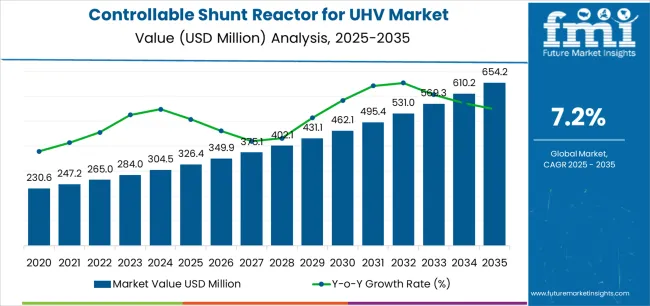
Manufacturing capabilities are advancing as leading power equipment providers invest in precision manufacturing facilities and proprietary control algorithms to meet growing market demand for enhanced switching speed and reduced harmonic distortion. The technology landscape continues evolving with innovations in digital control systems, advanced magnetic materials, and real-time monitoring platforms that enhance voltage regulation precision while reducing equipment footprint requirements. Power equipment manufacturers and electrical engineering specialists are collaborating extensively to develop next-generation controllable reactor products that address specific application requirements across transmission networks, renewable energy integration projects, and industrial power distribution systems.
Quality standards are becoming increasingly stringent as applications demand higher voltage ratings and greater reliability under extreme operating conditions including temperature variations, electromagnetic interference, and seismic activity exposure. Industry certification programs and validation protocols ensure consistent product performance while supporting market confidence in controllable reactor technology adoption across critical power transmission infrastructure and regulated utility environments. Regulatory compliance requirements for power equipment and transmission system applications are driving investments in comprehensive quality management systems and testing protocols throughout the manufacturing supply chain.
International collaboration is accelerating market development as major transmission projects require coordinated efforts between multiple equipment providers and utility operators. Global power companies are establishing standardized specifications for controllable reactor performance that influence worldwide manufacturing standards and create opportunities for specialized power equipment suppliers. Electrical engineering firms are forming strategic partnerships with reactor technology developers to create application-specific solutions tailored to emerging grid architectures and renewable energy integration requirements.
Investment patterns are shifting toward integrated solution development as major utility operators seek comprehensive controllable reactor systems that combine voltage regulation capabilities with advanced monitoring integration and predictive maintenance features. Power companies are forming joint ventures with equipment providers to develop customized control platforms, while utility operators are acquiring stakes in specialized reactor technology companies to ensure access to cutting-edge control technologies for their transmission and distribution programs. This trend toward strategic partnerships and technology integration is reshaping competitive dynamics across the power equipment value chain.
Market maturation is evident in the emergence of specialized application segments that demand unique reactor characteristics and performance specifications. Ultra-high voltage transmission applications require extremely stable control performance and electromagnetic compatibility under high-voltage operating requirements, while renewable energy integration systems need controllable reactors that maintain accuracy and reliability when handling variable power generation and grid synchronization requirements. These specialized requirements are driving innovation in control technologies, magnetic core designs, and integration methodologies that extend beyond traditional voltage regulation and reactive power compensation applications.
| Metric | Value |
|---|---|
| Market Value (2025) | USD 326.4 million |
| Market Forecast Value (2035) | USD 654.2 million |
| Forecast CAGR (2025-2035) | 7.2% |
| UHV TRANSMISSION EXPANSION | RENEWABLE ENERGY INTEGRATION | GRID MODERNIZATION INITIATIVES |
|---|---|---|
| Ultra-High Voltage Networks - Global expansion of UHV transmission infrastructure requiring sophisticated controllable reactor systems for voltage regulation, reactive power management, and grid stability during long-distance power transmission with enhanced control accuracy and real-time adjustment capabilities. | Variable Generation Sources - Integration of wind and solar power installations implementing controllable reactor technology for grid stabilization, voltage control, and power quality management requiring precision control systems for intermittent renewable energy sources with superior response time and operational flexibility. | Smart Grid Development - Advanced power grid infrastructure implementing intelligent controllable reactor systems for automated voltage regulation, load balancing, and system optimization requiring integrated monitoring capabilities and remote control functionality with comprehensive data analytics and predictive maintenance features. |
| Power System Stability - Transmission network enhancement requiring specialized controllable reactor technology for voltage support, oscillation damping, and transient stability applications with superior electromagnetic compatibility under dynamic grid conditions and environmental variations. | Grid Integration Standards - Renewable energy connectivity requirements implementing controllable reactor solutions for power factor correction, harmonic filtering, and voltage regulation compliance requiring robust hardware platforms and comprehensive software integration capabilities. | Infrastructure Investment - Utility modernization programs requiring controllable reactor technology for transmission efficiency, power loss reduction, and operational optimization with cost-effective control solutions and flexible installation options across multiple grid configurations. |
| Regulatory Compliance - Power system reliability standards requiring enhanced voltage control systems implementing controllable reactor technology for grid code compliance, power quality maintenance, and emergency response with certified performance under regulatory testing protocols. | Energy Storage Integration - Battery storage and pumped hydro facilities requiring controllable reactors for grid synchronization, voltage support, and power conditioning applications with standardized communication protocols and data exchange capabilities. | Digital Control Systems - Advanced automation and control technology requiring integrated controllable reactor platforms for real-time grid management, predictive analytics, and operational efficiency with simplified installation and maintenance procedures. |
| Category | Segments / Values |
|---|---|
| By Type | Dry Type; Oil-Immersed Type; Air-Core Type; Iron-Core Type; Others |
| By Application | HVDC Transmission; HVAC Transmission; Renewable Energy Integration; Industrial Power Systems; Others |
| By Voltage Rating | 220kV-400kV; 500kV-800kV; Above 800kV |
| By Control Method | Thyristor Controlled; Magnetically Controlled; Hybrid Control; Others |
| By End-User | Transmission System Operators; Renewable Energy Developers; Industrial Users; Utility Companies; Others |
| By Distribution Channel | Direct Sales to Utilities; Engineering Contractors; System Integrators; Equipment Distributors |
| By Region | North America; Europe; Asia Pacific; Latin America; Middle East & Africa |
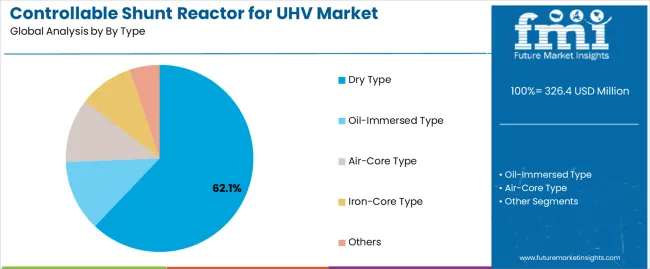
| Segment | 2025-2035 Outlook |
|---|---|
| Dry Type | Leader in 2025 with 62.1% market share; optimal performance and maintenance advantages for UHV transmission applications. Widely adopted for high-voltage substations and transmission facilities requiring minimal maintenance. Momentum: exceptional growth across utility and transmission system segments. Watchouts: higher initial investment and specialized installation requirements. |
| Oil-Immersed Type | Significant segment with 28.3% share, favored for high-power applications and extreme voltage requirements offering superior cooling performance and extended operational life under harsh conditions. Momentum: strong growth in industrial and renewable energy integration applications. Watchouts: environmental considerations and complex maintenance procedures. |
| Air-Core Type | Specialized segment offering advanced performance characteristics for critical transmission applications requiring superior electromagnetic compatibility and reduced maintenance requirements. Momentum: growing adoption in smart grid and automation projects. Watchouts: higher cost and specialized technical requirements. |
| Others | Includes iron-core reactors and hybrid designs for specialized voltage control applications. Momentum: selective growth in industrial and specialized transmission applications. |
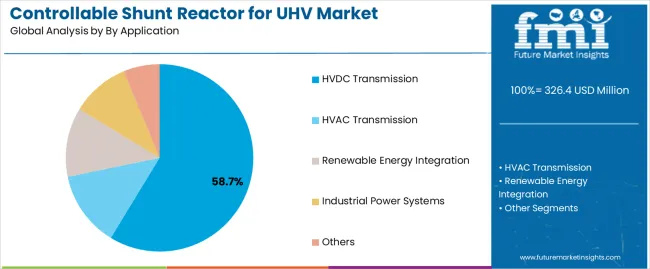
| Segment | 2025-2035 Outlook |
|---|---|
| HVDC Transmission | Largest application segment in 2025 at 58.7% share, driven by global expansion of high-voltage direct current transmission projects and utility operator adoption requiring precision voltage control technology. Includes long-distance transmission lines, submarine cables, and grid interconnection systems. Momentum: robust growth from renewable energy integration and cross-border power trading expansion. Watchouts: technical complexity and specialized installation requirements. |
| HVAC Transmission | Critical segment representing 24.6% share, experiencing steady growth from alternating current transmission system upgrades and grid modernization requirements. Momentum: consistent growth as utilities upgrade transmission infrastructure and implement smart grid technologies. Watchouts: competition from alternative voltage regulation technologies. |
| Renewable Energy Integration | Growing segment at 12.8% share for wind farm connections, solar power integration, and energy storage applications requiring specialized voltage regulation and power quality management. Momentum: strong growth from renewable energy expansion and grid integration requirements. Watchouts: variable demand patterns and project-specific requirements. |
| Others | Includes industrial power systems, research facilities, and specialized transmission applications. Momentum: diverse growth opportunities across multiple power system sectors. |
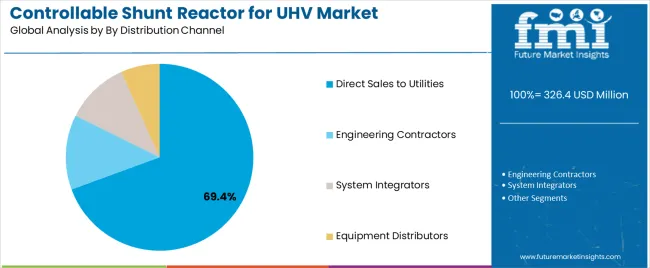
| Distribution Channel | Status & Outlook (2025-2035) |
|---|---|
| Direct Sales to Utilities | Dominant channel in 2025 with 69.4% share for utility company applications. Provides direct technical support, customized solutions, and comprehensive service packages for major transmission projects. Momentum: strong growth driven by utility infrastructure investment and transmission expansion programs. Watchouts: long sales cycles and complex procurement processes. |
| Engineering Contractors | Technical distribution serving power system contractors and project developers with specialized equipment portfolios and installation support capabilities. Momentum: moderate growth as market expands into renewable energy and industrial applications. Watchouts: project timing uncertainties and technical specification complexity. |
| System Integrators | Collaborative channel for comprehensive power system projects with electrical engineering firms and technology integration specialists. Momentum: growing importance as power systems become more complex and integrated. |
| Equipment Distributors | Regional distribution network serving smaller utilities and specialized applications with standard product offerings and technical support services. Momentum: steady growth in regional markets and replacement applications. |
| DRIVERS | RESTRAINTS | KEY TRENDS |
|---|---|---|
| UHV Grid Expansion across ultra-high voltage transmission infrastructure and long-distance power delivery systems creating substantial demand for specialized controllable reactor devices supporting voltage regulation, reactive power management, and grid stability applications requiring precise control characteristics. | High Capital Investment and complex installation requirements limit accessibility across smaller utility operators and regional power systems with limited infrastructure upgrade budgets affecting market penetration in emerging regions. | Digital Control Integration - Advanced controllable reactor systems incorporating digital control algorithms, remote monitoring capabilities, and predictive maintenance features for enhanced operational efficiency and grid management optimization. |
| Renewable Energy Growth - Solar and wind power expansion and grid integration requirements driving adoption of controllable reactor technology for voltage support, power quality management, and grid stability applications across variable generation sources. | Technical Complexity - Installation requirements, system integration challenges, and specialized maintenance procedures affect deployment timelines and operational capabilities for utilities lacking dedicated high-voltage equipment expertise. | Smart Grid Technology - Integration with intelligent grid infrastructure and automated control systems delivering enhanced monitoring capabilities, real-time optimization, and comprehensive data analytics for improved power system management. |
| Power System Reliability - Grid stability enhancement and voltage control requirements driving implementation of advanced controllable reactor systems for transmission network optimization, load balancing, and emergency response applications. | Regulatory Standards - Evolving power system regulations and grid code requirements create compliance challenges for controllable reactor deployment affecting market adoption and technology development timelines across different regulatory jurisdictions. | Modular Design Concepts - Development of standardized controllable reactor modules and scalable system architectures enabling flexible installation options, reduced engineering costs, and improved maintenance accessibility across diverse applications. |
| Grid Modernization Programs - Utility infrastructure upgrade and transmission system enhancement initiatives requiring controllable reactor technology for operational efficiency, power loss reduction, and automated control applications. | Supply Chain Constraints - Specialized component availability, manufacturing lead times, and technical expertise requirements create delivery challenges affecting project timelines and cost considerations for major transmission installations. | Environmental Compliance - Advanced reactor technologies incorporating eco-friendly designs, reduced electromagnetic emissions, and improved energy efficiency meeting stringent environmental standards and regulatory requirements. |
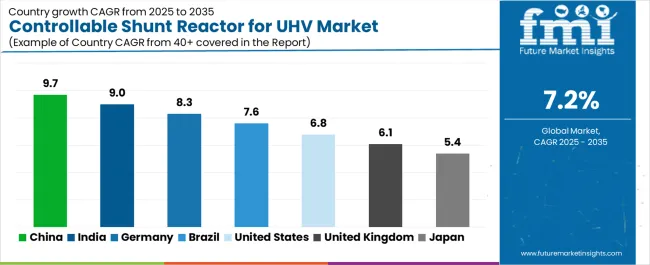
| Country | CAGR (2025-2035) |
|---|---|
| China | 9.7% |
| India | 9.0% |
| Germany | 8.3% |
| Brazil | 7.6% |
| United States | 6.8% |
| United Kingdom | 6.1% |
| Japan | 5.4% |
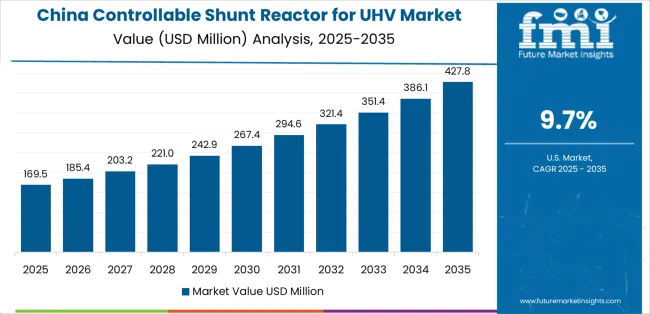
China is projected to exhibit exceptional growth with a market value of USD 264.9 million by 2035, driven by massive UHV transmission development programs and comprehensive power grid modernization initiatives creating substantial opportunities for controllable reactor suppliers across state-owned utilities, transmission system operators, and renewable energy integration projects. The country's ambitious smart grid development programs including national UHV transmission networks and intelligent power system infrastructure expansion are creating unprecedented demand for specialized controllable reactor systems. Major utility companies and power equipment manufacturers including State Grid Corporation, China Southern Power Grid, and XD Group are establishing comprehensive reactor development programs to support large-scale transmission projects and advanced grid infrastructure applications.
India is expanding to reach USD 120.5 million by 2035, supported by extensive power sector development programs and comprehensive transmission infrastructure modernization initiatives creating demand for controllable reactor solutions across diverse utility and industrial application segments. The country's growing power generation capabilities and expanding transmission infrastructure are driving demand for voltage control components that provide exceptional reliability while supporting advanced grid system requirements. Utility companies and power facilities are investing in controllable reactor development to support growing electricity demand and grid stability enhancement requirements.
Germany is projected to reach USD 65.1 million by 2035, supported by the country's leadership in power system engineering technology and advanced grid infrastructure requiring sophisticated controllable reactor solutions for renewable energy integration and transmission system applications. German utility operators are implementing cutting-edge voltage control platforms that support advanced coordination capabilities, operational precision, and comprehensive performance monitoring protocols. The market is characterized by focus on engineering excellence, technology innovation, and compliance with stringent power system safety and performance standards.
Brazil is growing to reach USD 43.2 million by 2035, driven by power infrastructure development programs and increasing transmission system capabilities creating opportunities for controllable reactor suppliers serving both utility operators and specialized power contractors. The country's expanding power sector and growing transmission infrastructure are creating demand for voltage control components that support diverse grid requirements while maintaining performance standards. Utility companies and power facilities are developing technology strategies to support operational efficiency and system reliability advancement.
The United States is projected to reach USD 30.5 million by 2035, expanding at a CAGR of 6.8%, driven by advanced power system technology innovation and specialized grid modernization applications supporting utility infrastructure and comprehensive transmission system applications. The country's established power engineering tradition including major utility companies and transmission facilities are creating demand for high-performance controllable reactor components that support operational advancement and reliability standards. Manufacturers and power system suppliers are maintaining comprehensive development capabilities to support diverse utility and technology requirements.
The United Kingdom is growing to reach USD 24.7 million by 2035, supported by power system technology heritage and established utility communities driving demand for advanced controllable reactor solutions across traditional grid systems and specialized transmission applications. The country's established electrical engineering heritage including major utility operators and power system capabilities create demand for voltage control components that support both legacy system advancement and modern grid applications.
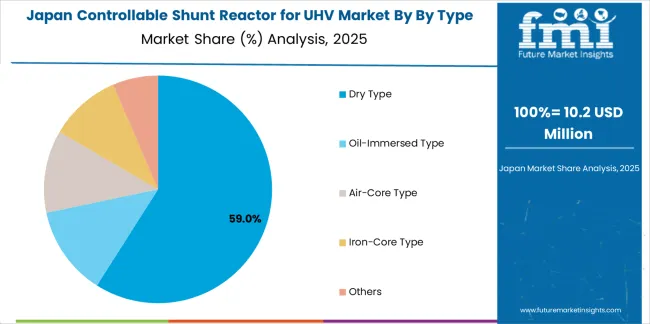
Japan is projected to reach USD 20.5 million by 2035, driven by precision power technology tradition and established manufacturing leadership supporting both domestic grid markets and export-oriented component production. Japanese companies maintain sophisticated controllable reactor development capabilities, with established manufacturers continuing to lead in voltage control technology and power equipment standards.
What is the market split by application focus in Europe?
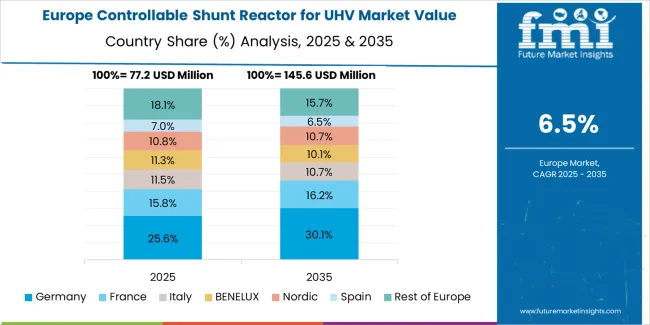
European Controllable Shunt Reactor for UHV operations are increasingly concentrated between German engineering excellence and specialized manufacturing across multiple countries. German facilities dominate high-performance controllable reactor production for renewable energy integration and transmission system applications, leveraging cutting-edge manufacturing technologies and strict quality protocols that command price premiums in global markets. British power system operators maintain leadership in grid technology innovation and voltage control method development, with organizations like National Grid and university research centers driving technical specifications that suppliers must meet to access major utility contracts.
Eastern European operations in Czech Republic and Poland are capturing specialized production contracts through precision manufacturing expertise and EU compliance standards, particularly in component fabrication and assembly technologies for power applications. These facilities increasingly serve as development partners for Western European grid programs while building their own power system expertise.
The regulatory environment presents both opportunities and constraints. European power system framework requirements create quality standards that favor established European manufacturers and utility operators while ensuring consistent performance specifications for critical transmission infrastructure and grid stability applications. Brexit has created complexity for UK grid collaboration with EU programs, driving opportunities for direct relationships between British operators and international controllable reactor suppliers.
Technology collaboration accelerates as utility operators seek voltage control advancement to support major renewable energy integration milestones and grid modernization timelines. Vertical integration increases, with major power system operators acquiring specialized manufacturing capabilities to secure component supplies and quality control for critical transmission programs. Smaller power contractors face pressure to specialize in niche applications or risk displacement by larger, more comprehensive operations serving mainstream utility and grid requirements.
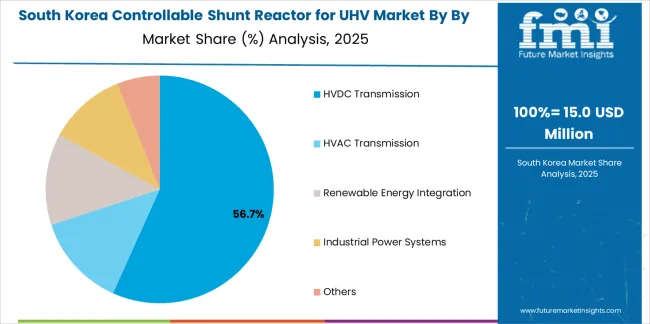
South Korean Controllable Shunt Reactor for UHV operations reflect the country's advanced power system capabilities and export-oriented technology development model. Major utility operators including Korea Electric Power Corporation and technology companies drive component procurement strategies for their transmission facilities, establishing direct relationships with specialized controllable reactor suppliers to secure consistent quality and performance for their grid development programs and advanced power system configurations targeting both domestic infrastructure and international collaboration projects.
The Korean market demonstrates particular strength in integrating controllable reactor technologies into smart grid platforms and advanced power system configurations, with engineering teams developing solutions that bridge traditional voltage control applications and next-generation grid systems. This integration approach creates demand for specific performance specifications that differ from conventional applications, requiring suppliers to adapt reactor capabilities and control system characteristics.
Regulatory frameworks emphasize power system reliability and grid stability, with Korean electrical standards often exceeding international requirements for controllable reactor systems. This creates barriers for standard component suppliers but benefits established manufacturers who can demonstrate utility-grade performance capabilities. The regulatory environment particularly favors suppliers with Korean power system qualification and comprehensive testing documentation systems.
Supply chain excellence remains critical given Korea's power system focus and international collaboration dynamics. Utility operators increasingly pursue development partnerships with suppliers in Japan, Germany, and specialized manufacturers to ensure access to cutting-edge controllable reactor technologies while managing infrastructure risks. Investment in power infrastructure supports performance advancement during extended grid development cycles.
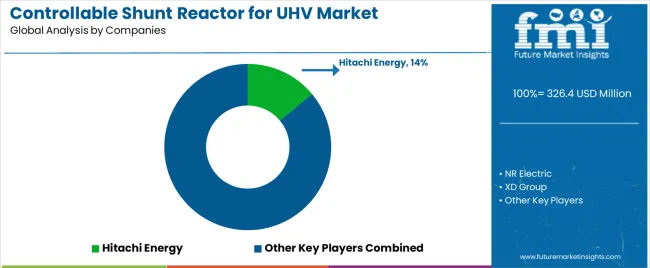
Profit pools are consolidating upstream in advanced reactor manufacturing and downstream in application-specific solutions for utility integration, transmission system applications, and renewable energy markets where voltage control performance, system integration complexity, and exceptional reliability command substantial premiums. Value is migrating from basic voltage regulation production to specification-driven, utility-ready controllable reactor systems where power electronics expertise, precision manufacturing capabilities, and proven grid integration experience create competitive advantages.
Several archetypes define market leadership: established European power equipment companies defending share through advanced reactor platform development and comprehensive utility integration support; Japanese technology suppliers leveraging manufacturing excellence and power system capabilities; Chinese manufacturers with transmission expertise and precision manufacturing heritage; and emerging technology providers pursuing cost-effective production while developing advanced control capabilities.
Switching costs - system integration, grid compatibility validation, utility certification - provide stability for established suppliers, while technological advancement requirements and renewable energy integration growth create opportunities for innovative power equipment manufacturers. Consolidation continues as companies seek manufacturing scale; direct utility partnerships grow for specialized applications while traditional power equipment distribution remains relationship-driven. Focus areas: secure utility and transmission system market positions with application-specific performance specifications and technical collaboration; develop controllable reactor technology and advanced manufacturing capabilities; explore specialized applications including renewable energy integration and smart grid infrastructure requirements.
| Stakeholder Type | Primary Advantage | Repeatable Plays |
|---|---|---|
| European Power Equipment Leaders | Advanced reactor platform expertise; proven utility integration; established transmission relationships | Precision manufacturing; technical innovation; utility certification support |
| Japanese Technology Suppliers | Manufacturing excellence; comprehensive power equipment development programs; established customer partnerships | Engineering collaboration focus; integrated solutions; technical consultation |
| Chinese Manufacturers | Power system expertise; precision technology leadership; trusted by major utility programs | Utility partnerships; application-specific specifications; transmission infrastructure collaboration |
| Emerging Technology Providers | Manufacturing efficiency; competitive pricing; rapid technology development | Production scaling; technology advancement; market entry strategies |
| Power Equipment Distributors | Technical distribution networks; utility service relationships | Power system expertise; inventory management; technical support services |
| Item | Value |
|---|---|
| Quantitative Units | USD 326.4 million |
| Type Segments | Dry Type; Oil-Immersed Type; Air-Core Type; Iron-Core Type; Others |
| Applications | HVDC Transmission; HVAC Transmission; Renewable Energy Integration; Industrial Power Systems; Others |
| End-Users | Transmission System Operators; Renewable Energy Developers; Industrial Users; Utility Companies; Others |
| Voltage Rating Segments | 220kV-400kV; 500kV-800kV; Above 800kV |
| Control Method Segments | Thyristor Controlled; Magnetically Controlled; Hybrid Control; Others |
| Distribution Channels | Direct Sales to Utilities; Engineering Contractors; System Integrators; Equipment Distributors |
| Regions Covered | North America; Latin America; Europe; Asia Pacific; Middle East & Africa |
| Key Countries | China; India; Germany; Brazil; United States; United Kingdom; Japan (+35 additional countries) |
| Key Companies Profiled | Hitachi Energy; NR Electric; XD Group; TBEA; ASTOR; FARAMAX; GE Vernova; Siemens Energy; ABB; Schneider Electric; Mitsubishi Electric; Toshiba Corporation; Hyosung Heavy Industries; BHEL (Bharat Heavy Electricals); Crompton Greaves Power; China XD Electric Co.; Shandong Taikai High Voltage Switchgear; Jiangsu Huapeng Group |
| Additional Attributes | Dollar sales by type and application; Regional demand trends (NA, EU, APAC); Competitive landscape; Utility vs. industrial adoption patterns; Power equipment manufacturing and system integration; Advanced reactor innovations driving voltage control enhancement, grid reliability, and power system stability excellence |
The global controllable shunt reactor for uhv market is estimated to be valued at USD 326.4 million in 2025.
The market size for the controllable shunt reactor for uhv market is projected to reach USD 654.2 million by 2035.
The controllable shunt reactor for uhv market is expected to grow at a 7.2% CAGR between 2025 and 2035.
The key product types in controllable shunt reactor for uhv market are dry type, oil-immersed type, air-core type, iron-core type and others.
In terms of by application, hvdc transmission segment to command 58.7% share in the controllable shunt reactor for uhv market in 2025.






Full Research Suite comprises of:
Market outlook & trends analysis
Interviews & case studies
Strategic recommendations
Vendor profiles & capabilities analysis
5-year forecasts
8 regions and 60+ country-level data splits
Market segment data splits
12 months of continuous data updates
DELIVERED AS:
PDF EXCEL ONLINE
Shunt Voltage References Market
Shunt Reactor Market Growth – Trends & Forecast 2020 to 2030
Fixed Shunt Reactor Market Size and Share Forecast Outlook 2025 to 2035
Variable Shunt Reactor Market Size and Share Forecast Outlook 2025 to 2035
Interatrial Shunt Market
Three Phase Shunt Reactor Market Size and Share Forecast Outlook 2025 to 2035
Oil Immersed Shunt Reactor Market Size and Share Forecast Outlook 2025 to 2035
Single Phase Shunt Reactor Market Size and Share Forecast Outlook 2025 to 2035
Hydrocephalus Shunt Market Analysis - Size, Share, and Forecast Outlook 2025 to 2035
Utility Based Shunt Reactor Market Size and Share Forecast Outlook 2025 to 2035
Air Core Fixed Shunt Reactor Market Size and Share Forecast Outlook 2025 to 2035
Renewable Based Shunt Reactor Market Size and Share Forecast Outlook 2025 to 2035
Air Core Variable Shunt Reactor Market Size and Share Forecast Outlook 2025 to 2035
Single Phase Variable Shunt Reactor Market Size and Share Forecast Outlook 2025 to 2035
Formaldehyde Removal Air Purifier Market Size and Share Forecast Outlook 2025 to 2035
Fortified Dairy Products Market Size and Share Forecast Outlook 2025 to 2035
Form-Fill-Seal (FFS) Films Market Size and Share Forecast Outlook 2025 to 2035
Formable Films Market Size and Share Forecast Outlook 2025 to 2035
Forchlorfenuron Market Size and Share Forecast Outlook 2025 to 2035
Formalin Market Size and Share Forecast Outlook 2025 to 2035

Thank you!
You will receive an email from our Business Development Manager. Please be sure to check your SPAM/JUNK folder too.
Chat With
MaRIA